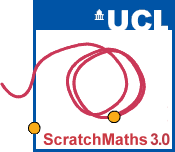Each ScratchMaths module of work comprises of a detailed teacher guide with step-by-step instructions, example solutions and curriculum links as well as pupil presentations that can be used in the classroom, Scratch starter projects and printable posters.
The materials can be used in conjunction with online or offline Scratch 2.0 which can be downloaded from the Scratch website: http://scratch.mit.edu
The Technical information page gives more information about setting up ScratchMaths within your classroom.
- Why ScratchMaths?
All primary schools in England are now required to introduce programming and computational thinking as part of the primary curriculum. Similar changes are being made in other education systems in a number of other countries. The ScratchMaths curriculum provides a high-quality solution for fulfilling these requirements for pupils aged 9-11 years for the following reasons:
- Explicit links with mathematics helps fit content into a busy teaching timetable by addressing important curriculum objectives in mathematics and computing as well as having suggested cross-curricular links with other subjects
- Programming in schools has been shown to have the potential to develop higher levels of mathematical thinking in relation to aspects of number and mathematical abstraction as well as problem solving abilities.
- Draws on alternative representations for challenging mathematical ideas providing a different approach for pupils who struggle to access mathematical concepts in the traditional ways.
- Over 40 hours of materials, including extensive challenges for gifted and talented pupils as well as suggested adaptations for lower attainers.
- Professional development
Professional development is a key component of the ScratchMaths curriculum as it encompasses not only the learning content but also a particular pedagogical approach, which we call the 5Es and is described briefly below.
Explore
Learning through exploration enables pupils to deal with different constraints and ambiguity through employing skills such as iterative thinking, problem solving and creativity. We therefore advocate the provision of opportunities to investigate key ScratchMaths ideas and try things out as well as to experiment with different strategies for debugging.
Explain
A crucial aspect of understanding ideas is being able to explain what has been learned and articulating the reasons behind a chosen approach. This helps with clarifying ideas, simply expressing them explicitly as well as in answering questions from peers. We encourage the incorporation of reflective questions and opportunities for discussion with others about the ideas that pupils have been exploring during ScratchMaths lessons.
Envisage
It is important to have a goal in mind when building a computer program and to predict what the outcome might be before trying it out. We believe in providing opportunities for the consideration of a program goal and encouragement to predict potential outcomes when using different strategies to realise this goal.
Exchange
Collaborating and sharing is a powerful way to learn. This allows you to 'decentre', while trying to see a problem from another's perspective as well as defend your own approach and compare it with others. We suggest the inclusion of meaningful opportunities to share and build on others' ideas, whilst acknowledging the on-going development of collaboration skills and providing appropriate scaffolding for these activities.
bridge
To make connections between programming and mathematics the ideas developed through Scratch programming have to be re-contextualised and re-built in the language of mathematics. We recommend any links with conventional mathematics to be made explicit during the activities and also for the provision of opportunities to re-contextualise their learning in an environment outside of Scratch.
Ideally, all teachers will have the opportunity to participate in the ScratchMaths PD events organised by one of our partners who have been involved in the project for several years and are experienced in providing PD sessions that appropriately prepare teachers to deliver ScratchMaths within their classrooms. In you are interested in attending ScratchMaths PD please get in contact with your nearest ScratchMaths PD provider:
Area Provider Contact details Bradford The Curriculum Innovation Service Paul Scott ticbradford.com
01274434818Devon Babcock Education Ruth Trundley Ruth.Trundley@babcockinternational.com London London Connected Learning Centre Joe Halloran info@londonclc.org.uk
02077207514Merseyside Hi-Impact Consultancy Gareth Griffiths office@hi-impact.co.uk
01516386283Somerset Somerset eLIM Julia Briggs elimadmin@somerset.gov.uk Stafford Entrust Jill Gosnay LT@entrust-ed.co.uk
03001118030- Technical setup
The ScratchMaths curriculum is designed for Scratch 2.0 (not 1.4) many aspects are not compatible with the older version.
You can choose whether need to use Scratch online (through the scratch.mit.edu website) or offline by downloading the offline editor from: https://scratch.mit.edu/scratch2download/.
You are able to request a Scratch teacher account to help you manage your pupils online accounts https://scratch.mit.edu/educators/#teacher-accounts. If you decide to use online Scratch we would still recommend that you have offline Scratch installed on your school computers as a back up.
Please note Scratch is currently not available on the iPad.
- Funders and partners
The ScratchMaths project was originally funded by the Education Endowment Foundation and formed part of a randomised control trial, which was undertaken by independent evaluators at Sheffield Hallam University, with the results due to be published at the end of 2017.
 Close
Close


